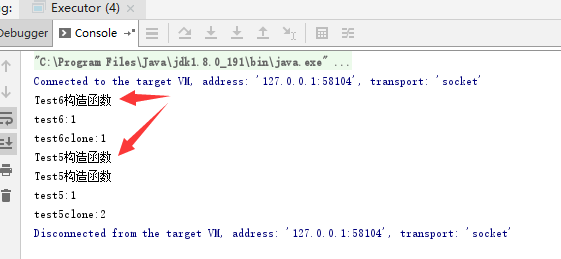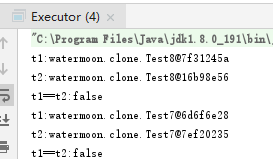本篇主要就java语言对原型模式扩展探讨理解,但是接触java的时间有限,所以不能保证没有谬误。主要内容就如下几个方面展开:
- java创建对象的几种方式
- 探讨clone方式-深复制与浅复制的问题
- serializable原型的实现
- 原型模式的实现
【java创建对象的方式】
java创建对象,最先我们肯定接触的是用new进行构建。之后我们会接触反射(反射有俩种方式直接使用class类和使用Constructor类创建),之后使用原型模式,肯定会了解到clone方式,之后因为clone存在浅复制的问题,所以了解到serializable方式创建。
1,new Object()。这种方式没有太多可说的
2,利用反射创建对象
1 public class CreateT { 2 //Class类创建 3 public static <T> T Create(Class<T> tClass) throws NoSuchMethodException,InstantiationException, IllegalAccessException, 4 IllegalArgumentException { 5 return (T) tClass.newInstance(); 6 } 7 //Constructor类创建 8 public static <T> T Create2(Class<T> tClass) throws NoSuchMethodException,InstantiationException, IllegalAccessException, 9 IllegalArgumentException, InvocationTargetException { 10 Constructor<T> constructor = tClass.getConstructor(); 11 return (T) constructor.newInstance(); 12 } 13 }
3,利用clone进行创建。因为Object对象有clone的方法,该方法能够创建对象,所以可以调用clone方法进行创建。
**Object中clone方法是protect类型,只有重载成public之后才能在类外使用,这处设计的确实挺精妙的。
4,使用序列化,反序列化创建对象(后面介绍)
【传统的原型方式-clone】
Object类为什么有一个protect类型的clone方法,这就是java当初设计的时候,为原型模式保留的,这我们就管它叫传统的原型模式。
public class Test3 implements Cloneable { @Override protected Object clone() throws CloneNotSupportedException { return super.clone(); } }
1 public interface Cloneable { 2 }
上面代码是一个标准的clone方法的标准实现,我们发现该方法可能会抛出异常,而且要实现空白接口Cloneable
那为什么要实现这个接口?什么情况下会抛出异常呢?下面我们看个例子
1 //实现Cloneable并且调用super.clone() 2 public class Test6 implements Cloneable { 3 @Override 4 protected Object clone() throws CloneNotSupportedException { 5 return super.clone(); 6 } 7 } 8 //未实现Cloneable未调用super.clone() 9 public class Test5{ 10 @Override 11 public Object clone() throws CloneNotSupportedException { 12 return new Test5(); 13 } 14 } 15 //未实现Cloneable并且调用super.clone() 16 public class Test4{ 17 @Override 18 public Object clone() throws CloneNotSupportedException { 19 return super.clone(); 20 } 21 } 22 //测试类 23 public static void main(String[] args) { 24 try { 25 Test6 test6=new Test6(); 26 Test6 test6clone=(Test6) test6.clone(); 27 System.out.println(test6clone.getClass()); 28 Test5 test5=new Test5(); 29 Test5 test5clone=(Test5) test5.clone(); 30 System.out.println(test5clone.getClass()); 31 Test4 test4=new Test4(); 32 Test4 test4clone=(Test4) test4.clone(); 33 System.out.println(test4clone.getClass()); 34 }catch (Exception ex){ 35 System.out.println(ex.getClass()); 36 } 37 }
运行结果:

通过运行结果我们可以得到一个结论:如果调用super.clone方法,必须实现空接口Cloneable,否则会抛出异常。那我们实现的时候,像Test5一样,使用构造函数构造,不调用super.clone()是不是就可以了。原则上应该没问题,不过还有一些细节的地方是不一致的,下面继续看测试代码:
1 //直接new 2 public class Test5{ 3 @Override 4 protected Object clone() throws CloneNotSupportedException { 5 return new Test5(); 6 } 7 public Test5(){ 8 System.out.println("Test5构造函数"); 9 } 10 private static int index=0; 11 public int getIindex() { 12 return iindex; 13 } 14 private int iindex=++index; 15 @Override 16 public String toString() { 17 return String.valueOf(iindex); 18 } 19 } 20 //使用super.clone() 21 public class Test6 implements Cloneable { 22 @Override 23 protected Object clone() throws CloneNotSupportedException { 24 return super.clone(); 25 } 26 27 public Test6(){ 28 System.out.println("Test6构造函数"); 29 } 30 private static int index=0; 31 public int getIindex() { 32 return iindex; 33 } 34 private int iindex=++index; 35 @Override 36 public String toString() { 37 return String.valueOf(iindex); 38 } 39 } 40 //测试代码 41 public static void main(String[] args) { 42 try { 43 Test6 test6=new Test6(); 44 Test6 test6clone=(Test6) test6.clone(); 45 System.out.println("test6:"+test6.toString()); 46 System.out.println("test6clone:"+test6clone.toString()); 47 Test5 test5=new Test5(); 48 Test5 test5clone=(Test5) test5.clone(); 49 System.out.println("test5:"+test5.toString()); 50 System.out.println("test5clone:"+test5clone.toString()); 51 }catch (Exception ex){ 52 System.out.println(ex.getClass()); 53 } 54 }
输出结果:

我们明显可以看出:super.clone是不走构造函数,并且私有变量也能复制;而直接使用new创建,会走构造函数,并且内部私有变量也可能会有变化。我们之前说创建对象的几种方式有clone,而没把他算到new Object中,因为clone压根就不会走构造函数!!!!
我们看下Object类的clone方法签名:
1 protected native Object clone() throws CloneNotSupportedException;
我们发现这有一个native的关键字,之前重来没见过的,百度之后才知道,native关键字代表与C语言(其他语言)交互,也就是说Object类的clone方法是用底层实现的,当然效率也会更高些。
【深复制与浅复制】
下面我们再看一个例子:
1 public class Test7 { 2 } 3 public class Test8 implements Cloneable { 4 public Test7 getTest7() { 5 return test7; 6 } 7 public void setTest7(Test7 test7) { 8 this.test7 = test7; 9 } 10 Test7 test7; 11 @Override 12 protected Object clone() throws CloneNotSupportedException { 13 return super.clone(); 14 } 15 } 16 public static void main(String[] args) { 17 try { 18 Test7 test7=new Test7(); 19 Test8 test8=new Test8(); 20 Test8 test8Copy= (Test8) test8.clone(); 21 System.out.println("test8==test8Copy:"+(test8==test8Copy)); 22 System.out.println("test8.getTest7==test8Copy.getTest7:"+(test8.getTest7()==test8Copy.getTest7())); 23 }catch (Exception ex){ 24 System.out.println(ex.getClass()); 25 } 26 }
运行结果:

重结果中我们可以看出test8和test8Copy对象不是同一个对象,但是test8和test8Copy内部引用的Test7对象是同一个对象,也就是说test8中的Test7被修改,test8Copy中的Test7也会被修改,这几乎就不是我们想要的。我们管这种复制叫浅复制。如果对象内所有属性都被复制我们叫做深复制。
【序列化】
如果我们想彻底深复制,可以使用序列化的方式,示例代码如下:
//需要实现Serializable public class Test7 implements Serializable { } //需要实现Serializable public class Test8 implements Serializable { public Test7 getTest7() { return test7; } public void setTest7(Test7 test7) { this.test7 = test7; } Test7 test7; @Override protected Object clone() throws CloneNotSupportedException { return super.clone(); } } //序列化帮助代码 public class CommonClone { public static <T> T deepclone(T instance) throws IOException, ClassNotFoundException { ByteArrayOutputStream bao = new ByteArrayOutputStream(); ObjectOutputStream oos = new ObjectOutputStream(bao); oos.writeObject(instance); //将对象从流中取出 ByteArrayInputStream bis = new ByteArrayInputStream(bao.toByteArray()); ObjectInputStream ois = new ObjectInputStream(bis); return (T) ois.readObject(); } } //测试代码 public class Executor { public static void main(String[] args) { try { Test7 t7=new Test7(); Test8 t8=new Test8(); t8.setTest7(t7); Test8 t8Copy = CommonClone.deepclone(t8); ComparableObj(t8,t8Copy); ComparableObj(t8.getTest7(),t8Copy.getTest7()); }catch (Exception ex){ System.out.println(ex.getClass()); } } private static <T>void ComparableObj(T t1,T t2){ System.out.println("t1:"+t1.toString()); System.out.println("t2:"+t2.toString()); System.out.println("t1==t2:"+(t1==t2)); } }
运行结果:

我们可以看见属性Test7也是不同的,实现了深复制。需要注意的是序列化也不会调用类的构造函数,可能与Object的clone方法机制类似,但不太明确
由于序列化和反序列化也是一个比较大的话题,这里就不展开讨论。这里只简单的介绍下,被序列化的对象以及其属性都要实现接口Serializable(和Cloneable一样,也不包含方法),如果不实现会抛出异常。
【总结】
- 如果不包含属性或者属性较少,并且内部使用,建议不必实现Cloneable接口,直接实现一个方法类似于copyInstance等,方法内部实现深复制即可
- 如果做为jar包给其他人使用,建议按照标准实现Cloneable接口,并内部实现深复制
- 对于部分接口可以将CommonClone类做成帮助类,实现序列化和反序列化,但是不建议将他作为深复制的工具,毕竟Serializable接口侵入性太高。
- 海空凭鱼跃,天高任鸟飞,对于原型模式,你只要能控制好深复制与浅复制,怎么做随你。
